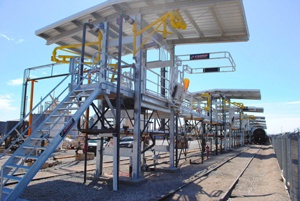What constitutes creating safe access to liquid terminal platforms and equipment has evolved dramatically in recent years. In the not-too-distant past, workers may have simply climbed a railcar for access, creating a worse-case risk scenario. “Fall protection” then advanced to incorporating a ramp to reach a railcar, and possibly a protective cage.
 Changing requirements have also impacted modern fall protection practices. In 2016, OSHA updated industry standards, requiring the regular inspection and maintenance of walking-working surfaces, and training of workers on fall and equipment hazards.
Changing requirements have also impacted modern fall protection practices. In 2016, OSHA updated industry standards, requiring the regular inspection and maintenance of walking-working surfaces, and training of workers on fall and equipment hazards.
As newer, more comprehensive liquid terminal fall protection solutions have emerged, the limitations of conventional ramps and cages have become more evident, with more and more railway companies seeking full fall protection systems.
Elevated Railway Cages for Full Fall Protection
Today, elevated railway cages are the gold standard for liquid terminal fall protection. Unlike abbreviated cages that do not protect the worker from gaps underneath the railing and floor holes, elevated cages encase the entire crash box. These advanced-engineered cages leave gaps no larger than 19” and floor holes no bigger than 12”, providing a higher level of fall protection for workers.
While some railway companies may question the necessity for investing in full coverage cages, elevated railway cages offer a low total cost of ownership, especially when the potential costs of fall-related injuries are taken into consideration.
The Bureau of Labor Statistics reported 247,120 non-fatal cases involving slips, trips, and falls (STFs) in 2014. Fatal occupational injuries from STFs totaled 849 in 2016, up from 800 in 2015. STFs are costly and can result in lost productivity, increased insurance premiums, and the need to train replacement workers. According to the Bureau of Labor Statistics (BLS) and Occupational Health and Safety Administration, STFs account for 12-15% of all workers’ compensation costs, and cost employers approximately $40,000 per incident. The toll on employees can include lost wages, temporary or permanent disability, depression, and long-term medical complications.
As awareness about the potential hazards of inadequate coverage has increased, railway companies have partnered with Carbis to create safer work environments. The first step towards creating a safer environment begins with a thorough assessment of your facility and equipment to identity any potential hazards. If your facility, and workers, are found to be at risk, a safety plan is created to address any hazards. Custom elevated rail safety cages—and other equipment as necessary—are then designed to meet a facility’s specifications and needs, and employees are fully trained on how to safely access terminals.
Creating a safer work environment for employees is critical to increasing throughput and maximizing your business’s bottom line. Elevated railway cages offer the best fall protection coverage, are low maintenance, and very durable. By investing in the “gold standard” of liquid terminal fall protection, you reduce workplace hazards, protect employees, and reduce the risk of costly fall-related injuries.
About Carbis Solutions
Sam Carbis Solutions Group, LLC is the world leader in building customized bulk loading access equipment and structural steel components. Carbis is passionate about partnering with customers to help keep people safer and products flowing. Since 2011, our elevated railway cage safety solutions have ensured railway companies across the U.S. have the highest quality fall protection systems in place.




